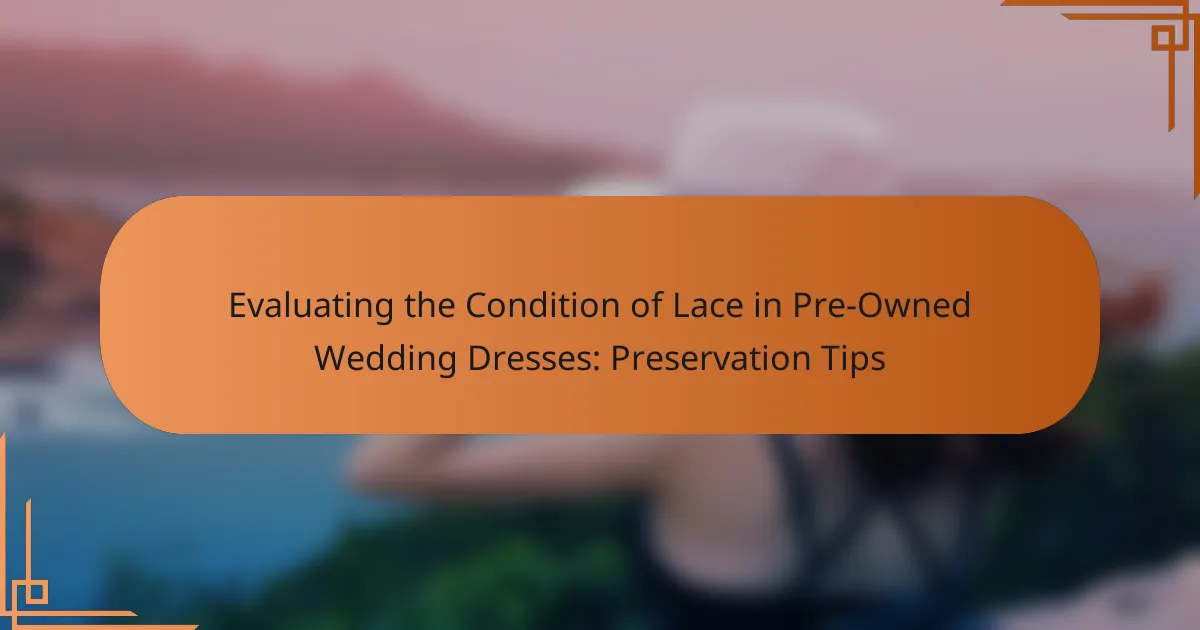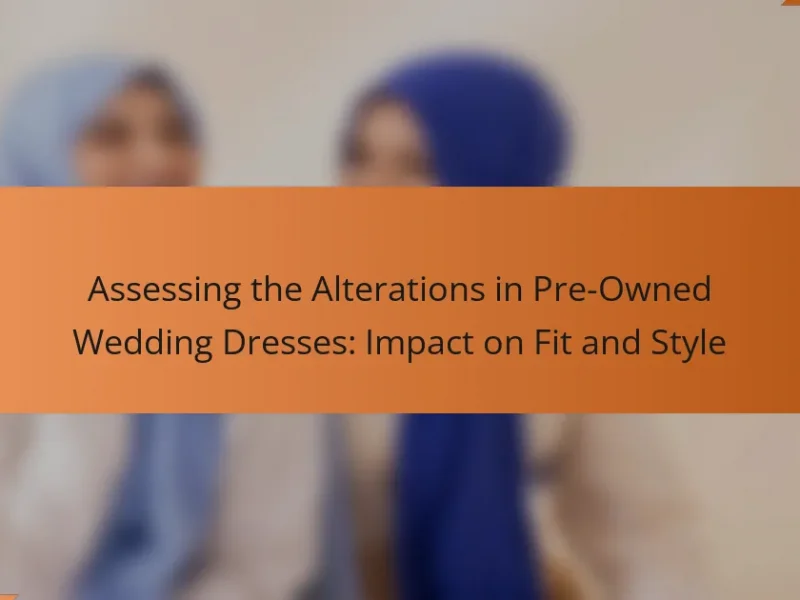Evaluating the condition of lace in pre-owned wedding dresses is essential for maintaining the garment’s integrity and aesthetic appeal. This process involves inspecting the lace for damage, such as fraying, discoloration, or holes, and assessing the stitching and overall texture. Proper care, including appropriate storage and gentle cleaning, can significantly extend the lifespan of lace. The article provides detailed tips for evaluating lace condition, identifying necessary repairs, and ensuring the dress remains beautiful and valuable over time.
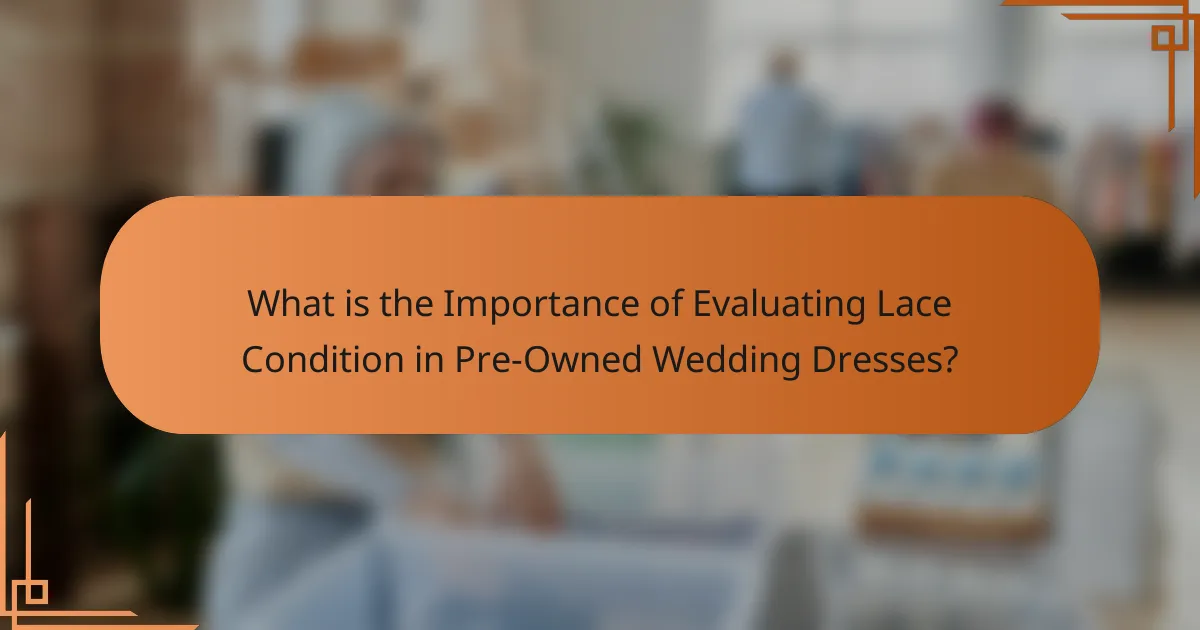
What is the Importance of Evaluating Lace Condition in Pre-Owned Wedding Dresses?
Evaluating the lace condition in pre-owned wedding dresses is crucial for ensuring the garment’s integrity and aesthetic appeal. Lace is often delicate and can be prone to damage, such as fraying or discoloration. Assessing its condition helps identify any necessary repairs or cleaning. This evaluation also influences the dress’s resale value. A well-maintained lace can enhance the overall beauty of the dress. Conversely, damaged lace may detract from its appearance and desirability. Regular inspection of lace can prevent further deterioration, ensuring longevity. Thus, evaluating lace condition is essential for both preservation and aesthetic reasons.
Why should you assess the lace condition before purchasing a pre-owned wedding dress?
Assessing the lace condition before purchasing a pre-owned wedding dress is crucial for ensuring quality and longevity. Lace can be delicate and prone to damage over time. Signs of wear, such as fraying or discoloration, can indicate overall dress condition. Damaged lace may require expensive repairs or replacement. Additionally, the integrity of the lace affects the dress’s aesthetic appeal. A thorough inspection helps buyers make informed decisions. Understanding the lace’s condition can also impact the dress’s resale value. Proper care and maintenance are essential for preserving lace in vintage garments.
What specific issues can arise from damaged lace?
Damaged lace can lead to several specific issues. First, it can compromise the overall aesthetic of the wedding dress. Visible tears or fraying can detract from the dress’s beauty. Second, damaged lace may weaken the structural integrity of the garment. This can result in further deterioration over time. Third, it can lead to increased maintenance needs. Repairs or replacements may become necessary, which can be costly. Lastly, damaged lace can affect the sentimental value of the dress. A wedding dress with issues may not hold the same emotional significance for the owner.
How does lace condition impact the overall appearance of the dress?
Lace condition significantly impacts the overall appearance of the dress. Well-maintained lace enhances the elegance and visual appeal of the garment. Conversely, damaged or discolored lace can detract from the dress’s beauty. For example, frayed edges or yellowing can create an unkempt look. This can lead to a perception of neglect or reduced quality. Clean and intact lace contributes to a polished and sophisticated appearance. Studies show that the condition of lace directly influences buyer perception and satisfaction. A dress with pristine lace is often perceived as more valuable and desirable.
What are the common types of lace found in wedding dresses?
The common types of lace found in wedding dresses include Chantilly lace, Alençon lace, and Venice lace. Chantilly lace is known for its delicate floral patterns and fine netting. Alençon lace features a more structured design with raised patterns, often used for its elegance. Venice lace is heavier and often incorporates intricate motifs, making it suitable for dramatic designs. These lace types are frequently chosen for their aesthetic appeal and texture in wedding fashion.
How can you differentiate between various lace types?
Different lace types can be differentiated by their construction methods, patterns, and materials. For example, Chantilly lace features a fine floral pattern and is often made from silk or nylon. Alençon lace is characterized by its raised cord outline and is typically made from cotton or silk. Venetian lace is known for its intricate designs and is usually crafted from linen or silk threads. Additionally, embroidery lace is distinguished by its decorative stitching on a base fabric. Each lace type has unique attributes that influence its appearance and texture. Identifying these characteristics helps in recognizing and preserving different lace types in pre-owned wedding dresses.
What are the unique characteristics of each lace type?
Cotton lace is soft and breathable, making it ideal for casual wear. It is often used in summer dresses and is known for its durability. Silk lace is luxurious and has a natural sheen, providing an elegant look. It is delicate and often used in high-end garments. Nylon lace is synthetic and highly versatile, known for its strength and resistance to wrinkles. It is commonly used in various clothing items and accessories. Polyester lace is durable and easy to care for, making it a popular choice for everyday wear. It retains color well and is often found in costume designs. Chantilly lace is characterized by its intricate floral patterns and fine netting. It is often used in formal wear and bridal gowns. Alençon lace features a raised design and is known for its ornate detailing. It is often used in couture fashion and bridal attire. Each lace type has unique characteristics that cater to different styles and occasions.
What factors influence the condition of lace in pre-owned wedding dresses?
The condition of lace in pre-owned wedding dresses is influenced by several factors. First, the age of the dress plays a significant role. Older lace may show signs of wear or yellowing. Second, the storage conditions impact lace quality. Dresses stored in humid or poorly ventilated areas can develop mold. Third, exposure to light can degrade lace fibers over time. Fourth, the type of lace material affects its durability. Some laces are more resilient than others. Fifth, previous cleaning methods used can also alter the condition of lace. Harsh chemicals can weaken fibers. Lastly, the frequency of wear contributes to lace condition. Dresses worn multiple times may have more noticeable damage.
How does age affect the integrity of lace?
Age negatively affects the integrity of lace. Over time, lace can become brittle and fragile. This deterioration occurs due to exposure to light, moisture, and environmental factors. Aging lace may also experience discoloration and yellowing. These changes compromise the lace’s structure and appearance. Historical textiles show that untreated lace can lose its strength within decades. Regular maintenance can mitigate some aging effects, but older lace may still require careful handling.
What role does storage play in preserving lace quality?
Storage plays a crucial role in preserving lace quality. Proper storage prevents damage from environmental factors such as light, humidity, and temperature. Lace should be stored in a cool, dry place away from direct sunlight to avoid fading and deterioration. Using acid-free tissue paper can help maintain the shape and prevent creasing. Additionally, avoiding plastic containers is important, as they can trap moisture and lead to mold growth. Regular checks on stored lace can identify any potential issues early. By following these storage guidelines, the integrity and beauty of lace can be maintained over time.
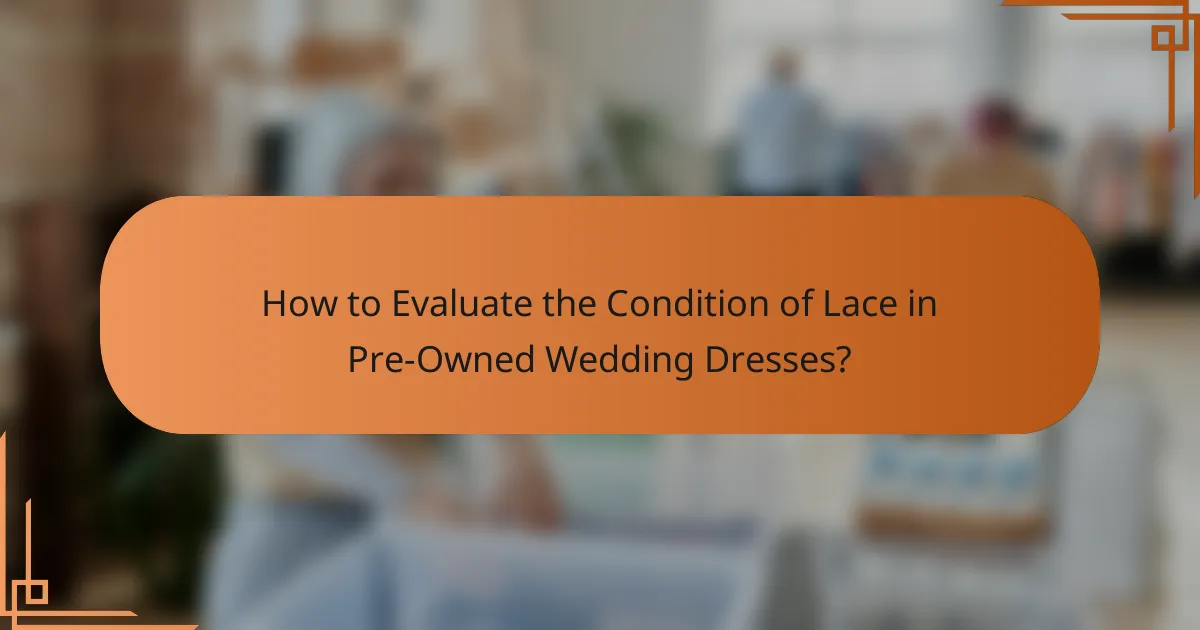
How to Evaluate the Condition of Lace in Pre-Owned Wedding Dresses?
To evaluate the condition of lace in pre-owned wedding dresses, inspect it closely for damage. Look for fraying edges, discoloration, or holes in the lace. Check the stitching to ensure it is intact and not unraveling. Assess the overall texture; lace should feel soft and not brittle. If the lace is yellowed, this may indicate age or improper storage. Use natural light to identify any stains that may not be visible in dim lighting. Additionally, consider the lace’s pattern and design; intricate designs may be more susceptible to damage. Always compare the condition with similar dresses to gauge its wear.
What steps should you take to inspect lace condition effectively?
To inspect lace condition effectively, follow these steps. First, lay the lace flat on a clean, white surface. This allows for better visibility of any imperfections. Next, examine the lace under good lighting. Bright light reveals stains, tears, or discoloration more clearly.
Then, check for any loose threads or fraying edges. These can indicate wear and may require repair. Look for areas of yellowing or discoloration, which could suggest age or improper cleaning.
Additionally, feel the texture of the lace. It should be smooth; rough patches may indicate damage. Lastly, consider using a magnifying glass for detailed inspection. This helps identify small issues that may not be visible to the [censured] eye.
How do you identify tears and fraying in lace?
To identify tears and fraying in lace, visually inspect the fabric closely. Look for any breaks in the lace pattern, which indicate tears. Check for loose threads along the edges, as they signify fraying. Gently pull on the lace to see if it unravels easily, which can reveal weak spots. Use a magnifying glass for a more detailed examination of intricate designs. Pay attention to areas that receive more wear, such as seams and hems. Regular maintenance can help prevent further damage. Proper cleaning and storage also play a role in preserving lace integrity.
What signs of discoloration should you look for?
Look for yellowing, browning, or grayish hues on lace. These signs indicate aging or damage. Additionally, check for spots or stains that differ from the original color. Uneven discoloration can signal exposure to light or moisture. If lace appears faded, it may have lost its original vibrancy. Inspect seams for color changes, as they can reveal wear. Discoloration can also occur due to improper storage or cleaning. Always assess the lace under natural light for accurate color evaluation.
What tools can assist in evaluating lace condition?
Tools that can assist in evaluating lace condition include magnifying glasses and light sources. Magnifying glasses help inspect the lace for tears, discoloration, or wear. They allow for close examination of intricate patterns and stitching. Light sources, such as LED lamps, illuminate the lace and reveal subtle defects. Proper lighting can highlight areas of damage that may not be visible in normal light. Additionally, fabric swatches can help compare the lace condition with similar materials. These tools collectively provide a thorough assessment of lace integrity.
How can a magnifying glass help in the evaluation process?
A magnifying glass aids in the evaluation process by allowing detailed inspection of lace. It helps identify flaws such as tears, stains, or discoloration that may not be visible to the [censured] eye. This tool enhances the ability to examine intricate patterns and stitching closely. By using a magnifying glass, evaluators can assess the overall quality and condition of the lace. This ensures that any necessary repairs or cleaning can be accurately determined. The precision offered by magnification is crucial for preserving the integrity of the fabric.
What lighting conditions are best for inspecting lace?
Natural daylight is the best lighting condition for inspecting lace. It provides even illumination and highlights intricate details. Direct sunlight may create harsh shadows, so diffused light is preferable. Soft, natural light allows for better visibility of any imperfections or discoloration. Using a lightbox can also simulate these conditions effectively. Adequate lighting helps in identifying the lace’s texture and patterns. This ensures a thorough evaluation of its condition before preservation.
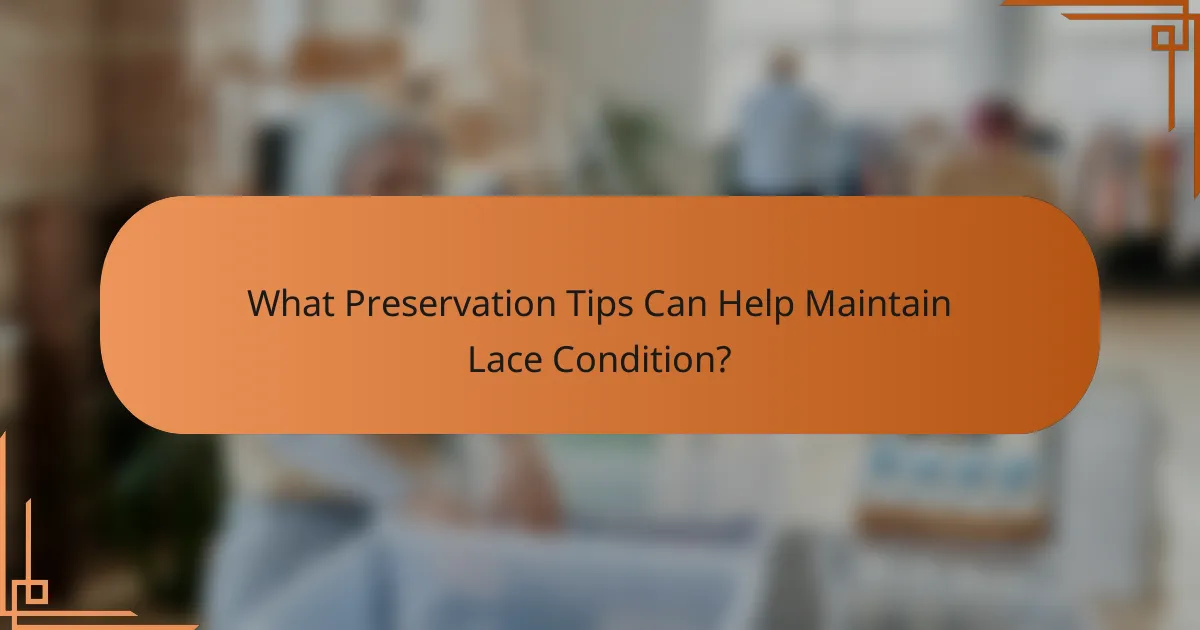
What Preservation Tips Can Help Maintain Lace Condition?
To maintain lace condition, store it properly in a cool, dry place. Avoid direct sunlight to prevent fading. Use acid-free tissue paper to cushion the lace when folding. Regularly inspect the lace for any signs of damage or wear. Clean lace gently with a soft brush to remove dust. Avoid using harsh chemicals or detergents during cleaning. If necessary, consult a professional cleaner experienced with lace. Proper care and storage can significantly extend the lifespan of lace.
How should you clean lace to preserve its condition?
To clean lace and preserve its condition, gently hand wash it in lukewarm water. Use a mild detergent specifically designed for delicate fabrics. Avoid wringing or twisting the lace, as this can cause damage. Instead, lightly press the lace between two clean towels to remove excess water. Rinse the lace thoroughly in cool water to eliminate any detergent residue. Air dry the lace flat on a clean, dry towel away from direct sunlight. This method maintains the integrity and appearance of the lace.
What cleaning products are safe for delicate lace?
Mild detergents specifically formulated for delicate fabrics are safe for cleaning delicate lace. Look for products labeled as gentle or suitable for silk and lace. Brands like Woolite or Eucalan offer options that are effective yet non-damaging. Avoid bleach or harsh chemicals as they can weaken the fibers. Always perform a patch test on a small, inconspicuous area before full application. This ensures that the cleaning product does not cause discoloration or damage. Following these guidelines helps maintain the integrity of delicate lace.
How can you avoid damaging lace during the cleaning process?
To avoid damaging lace during the cleaning process, handle it gently and use appropriate cleaning methods. Always check the care label for specific instructions. Hand washing is preferable to machine washing, as it minimizes agitation. Use cold water and a mild detergent specifically designed for delicate fabrics. Avoid wringing or twisting the lace, as this can distort its shape. Instead, gently press out excess water by laying it flat on a clean towel. Air drying is recommended; do not use heat sources as they can cause shrinkage or damage. Lastly, store lace items flat or rolled to prevent creasing or tearing.
What storage practices can help maintain lace quality?
Store lace in a cool, dry place to maintain its quality. Avoid exposure to direct sunlight, which can cause fading. Use acid-free tissue paper to wrap lace items gently. This prevents creasing and protects delicate fibers. Store lace in breathable cotton or linen bags. Plastic can trap moisture and lead to mildew. Regularly check stored lace for signs of damage or deterioration. Proper storage extends the lifespan of lace items significantly.
How should you fold or hang a dress to protect the lace?
To protect the lace, hang the dress using padded hangers. Padded hangers prevent pressure marks and maintain the dress’s shape. Ensure the lace is not bunched or pulled. Alternatively, fold the dress carefully with tissue paper between layers. This method minimizes friction and protects delicate lace. Store the folded dress in a breathable garment bag. Avoid plastic bags, as they can trap moisture and damage lace. Proper storage conditions help preserve the integrity of the lace.
What environmental factors should be considered in storage?
Temperature, humidity, light exposure, and air quality are essential environmental factors in storage. Temperature should be stable, ideally between 65-70°F. High humidity can lead to mold and mildew, so aim for 40-60% relative humidity. Light exposure can cause fabric fading and deterioration, so store items in dark or UV-filtering environments. Air quality is crucial; pollutants can damage delicate materials. Proper ventilation helps reduce moisture buildup and prevents odors. These factors collectively ensure the preservation of lace and other fabrics in wedding dresses.
What are some common mistakes to avoid when preserving lace?
Common mistakes to avoid when preserving lace include using improper cleaning methods. Harsh chemicals can damage delicate fibers. Additionally, not storing lace in breathable materials can lead to mold and mildew. Avoid folding lace tightly, as this can create creases and damage the fabric. Not using acid-free tissue paper when wrapping lace can also cause discoloration. Lastly, neglecting to keep lace away from direct sunlight can result in fading. Each of these mistakes can compromise the integrity and appearance of the lace.
How can improper handling affect lace condition?
Improper handling can significantly damage lace condition. Lace is delicate and can easily fray or tear when mishandled. Rough handling may lead to snagging on surfaces or clothing. Improper storage can cause creases or permanent folds in the fabric. Exposure to moisture can result in mildew or discoloration. Additionally, using the wrong cleaning methods can weaken the fibers. Each of these factors can ultimately compromise the integrity and appearance of lace. Proper care is essential for maintaining lace quality over time.
What should you avoid using on lace to prevent damage?
Avoid using bleach on lace to prevent damage. Bleach can weaken the delicate fibers of lace. It may cause discoloration and irreversible damage. Additionally, avoid using harsh detergents. These can strip the lace of its natural oils. Instead, opt for gentle cleaning solutions. Hand washing with mild soap is preferable. Always air dry lace items away from direct sunlight. Heat can also cause lace to warp or shrink.
What are the best practices for long-term preservation of lace in wedding dresses?
The best practices for long-term preservation of lace in wedding dresses include proper cleaning, storage, and environmental control. First, lace should be dry cleaned by a professional experienced with delicate fabrics. This removes stains and prevents deterioration. Next, store the dress in a breathable garment bag made of cotton or muslin. Avoid plastic bags, as they can trap moisture and promote mildew.
Additionally, keep the dress in a cool, dark place to protect it from light and humidity. Light exposure can cause fading and weaken the fibers. Use acid-free tissue paper to cushion the lace and prevent creasing. Regularly check the dress for any signs of damage or pests.
These practices help maintain the integrity of the lace over time. Proper care can extend the lifespan of the fabric significantly. Following these guidelines ensures that the lace remains beautiful for future generations.
The main entity of this article is the evaluation of lace condition in pre-owned wedding dresses. The article emphasizes the importance of assessing lace for damage, discoloration, and overall integrity, as these factors significantly influence the dress’s aesthetic appeal and resale value. It outlines common types of lace, methods for effective inspection, and preservation tips to maintain lace quality over time. Additionally, it highlights the impact of environmental factors and proper storage practices on the longevity of lace, providing readers with essential guidelines for caring for their wedding dresses.
